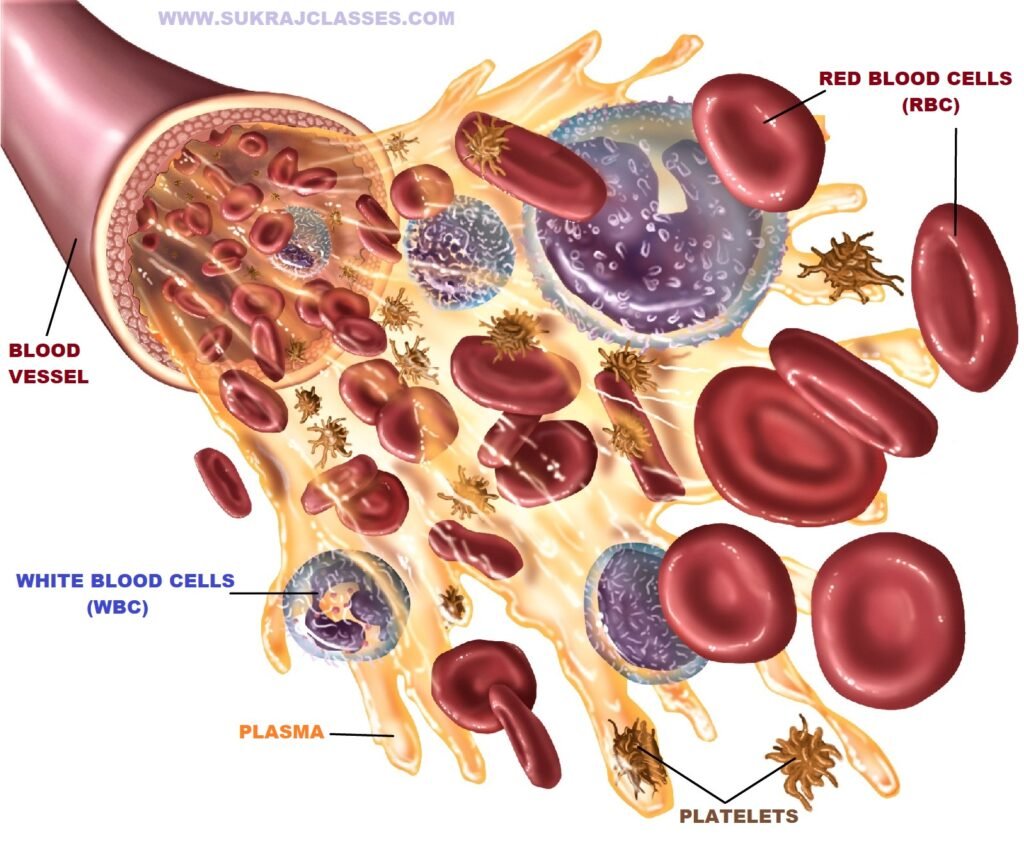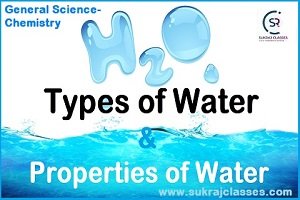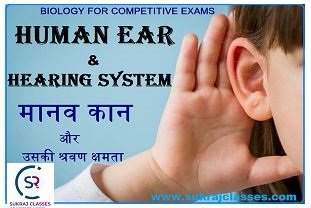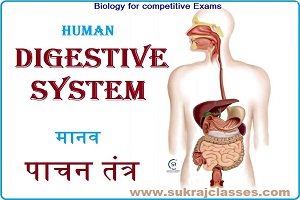
Blood in Human Body (मानव-रक्त) – Biology Topic.
Biology Science topic- “Blood in Human Body (मानव-रक्त)”, is important for all competitive exams like CET, SSC CGL, SSC CHSL, RRB NTPC, UPSC and for other state civil services exams. In these exams, almost 4-5 questions are coming from Biology. Let’s start the topic – Blood in Human Body (मानव-रक्त):
Blood in Human Body
(मानव-रक्त)
Blood is a body fluid with a combination of plasma and cells. It circulate necessary substances such as nutrients and oxygen to the cells and transports metabolic waste products away from those same cells.
Study of blood is called – HEMATOLOGY.
The main functions of blood are to transport oxygen, carbon dioxide, water, nutrients, hormones and waste around the body. Blood also fights infection and regulates temperature.
Basic Composition of blood:
- Plasma constitutes for about 54% of our blood. 92% of it is water.
- White blood cells and platelets constitute for about 1% of our blood.
- Red blood cells constitute for about 45% of our blood.
Blood has four main components:
- Plasma
- Red blood cells
- White blood cells
- Platelets

1. PLASMA –
It is Liquid portion of Blood. It contains 92 percent water, constitutes 54 % of total blood volume. This is a clear, pale yellow liquid, which carries all the blood cells and platelets and chemicals such as hormones and glucose.
- The blood plasma volume totals of 2.7–3.0 litters in an average human.
FUNCTION:
- Plasma circulates dissolved nutrients, such as glucose, amino acids, and fatty acids (dissolved in the blood or bound to plasma proteins), and removes waste products, such as carbon dioxide, urea, and lactic acid.
- It helps in maintaining a satisfactory blood pressure.
- It supplies critical proteins for blood clotting and immunity.
- It acts as Medium for exchange of vital minerals such as sodium and potassium and helps to maintain a proper pH (acid-base) balance in the body, which is critical to cell function.
2. RED BLOOD CELLS –
⇒ main function is to carry oxygen.
- Red blood cells are responsible for carrying oxygen round the body, and collecting carbon dioxide and taking it back to the lungs where it can be breathed out.
- Approximate 80% Oxygen carrying capacity of blood is due to presence of hemoglobin.
- Red blood cells are disc-shaped cells containing hemoglobin.
-
- hemoglobin (hemo means — iron-containing).
- Deficiency of hemoglobin cause – Anemia.
- Increase of Hemoglobin cause – Siderosis.
- Amount of Hemoglobin in normal human being is – 12 to 16 g/ 100 ml of blood.
- These cells are red because they hold a red colored chemical called hemoglobin. This chemical, which contains iron, carries oxygen enables the cells to pick up and deliver oxygen to all parts of the body, then pick up carbon dioxide and remove it from tissues.
- Red blood cells are being made all of the time in the bone marrow inside many bones of the body, such as the bones of the pelvis and thighs.
- Life of RBC is about 4 months (120 days) and are then broken down into pigments called bilirubin and biliverdin in the liver.
- Its destruction takes place in liver & spleen. Therefore, liver is called grave of RBC.
- RBCs have no nucleus. (Cell without nucleus is called- prokaryotic cells).
- Oxy-hemoglobin = oxygen rich hemoglobin,
- Deoxyhemoglobin= low oxygen hemoglobin.
- Spleen (प्लीहा) is regarded as “Grave-yard (कब्रगाह)” of RBC.
- Deficiency of oxygen cause- increase in No of RBC which is known as Hypoxia.
- Rapidly increase in RBC cause to Death.
- Reddish check of Hilly-peoples due to slowly increase of nos. of RBC.
- Thalassemia: It is a genetic disorders in which suffering person have defected bone-marrow due to this life of RBC goes to decrease continuous.
3. WHITE BLOOD CELLS:-
- White blood cells act as the primary defense (Fighter) of the body against germs and infection.
- There are normally around 5,000 to 7,000 white cells in a millilitre of blood, but the number of white cells goes up a lot when we get sick (maybe up to 25,000).
- The white blood cells work with special proteins called antibodies, which also travel in the blood, to protect against diseases.
- White blood cells, also called leukocytes. They are essential for good health.
- Its life span is from 2 to 5 days.
- White blood cells have nuclei and are also made in the bone marrow.
- There are 7 types of WBC in which 3 important type of WBC are –
-
- Eosinophils: – during whether change, it fight against cold and cough.
- Basophiles: – work during any wound or damage in body.
- Neutrophils: – work during attack of any bacteria of fungus on body these antibody & antigen fight. For eg: during Viral Fever.
- Among all these WBC, Neutrophils present in maximum value.
- Antibiotic medicine, increase the no of Neutrophils to protect against disease.
Note:
- Ratio in between RBC : WBC = 500: 1
- Effect of AIDS ⇒ WBC rapidly decrease.
4. PLATELETS:-
- It is main substance in blood which is responsible for clotting.
- Platelets are the cells that circulate within our blood and bind together when they recognize damaged blood vessels. The platelets join together with a protein called fibrinogen to make a sort of web to form a clot, which stops the flow of blood out of a blood vessel.
- There are 20 Factors involves in clotting of the blood. For examples: Vitamin –K, Calcium, heparin, prothrombin etc.
- Nos. of Platelets in Human body = 1.5 to 4.5 lakhs.
- In Dengue fever: Platelets decrease rapidly.
BLOOD DONER AND RECEIVER:
- Our immune system does not damage cells in our own bodies because it recognises that they are ours. If cells from someone else’s body are placed in our body, our immune system recognises that they are not ours, and destroys them.
- For most body cells there are lots of different antigens that tell our immune system that something does not belong in our body, but for red blood cells (RBC) there are only a few main antigens (A, B and Rh) on their surface.
- There are only four main types of blood:-
- A (with An antigen on the surface of the red blood cells, but not B)
- B (with B antigen, but not A)
- AB (with both A and B)
- O (neither A nor B)
Blood Groupings
- Father of Blood Grouping:Karl Landsteiner. He discovered A, B and O blood groups.
- DE-Castello and Adriano-Sturli discovered AB blood groups.
- Blood types are inherent.
- In starting these were symbolized in Greek-words. Later alpha became A, beta became B, alpha-beta become AB, Nil as O.
α as ⇒ A
β as ⇒ B
αβ as ⇒ AB
Nil as ⇒ O
| Blood Groups Classification. | ||
| Blood Group | Can donate to | Can receive from |
| A | A, AB | A, O |
| B | B, AB | B, O |
| AB | AB | A, B, AB, O |
| O | A, B, AB, O | O |
Sometimes people need extra blood because they have lost more than the body can make in a short time or they are not making enough red blood cells (this is called anemia).
Doctors can give blood from one person to another in what is called Blood–Transfusion (रक्तदान).
The blood that someone is given is ‘matched’ so that it won’t be destroyed by their immune system.
- Type A blood can go to anyone who has type A or AB.
- Type B blood can go to anyone with B or AB.
- AB blood can only go to a person with AB blood.
- O can be given to anyone, so someone with that blood is called a ‘Universal-donor.
- A person with type A can only take blood from someone with type A or O.
- Type B can only take blood from someone who is B or O.
- AB can receive blood from anyone. This is known as being a ‘Universal-receiver.’
- Type O can only receive blood from someone who is type O.
RH factor:
• It is a blood antigen found in RBC.
• A person can be Rh+ or Rh- depending upon the presence of Rh factor in RBC
• Rh+ can receive blood from both Rh+ and Rh- but Rh- can receive blood only from Rh- only
Blood transfusion techniques was developed by Dr. James Blundell.
Scientist William Harvey discovered 2 process:
a) Blood Transfusion.
b) Process of Blood- Circulation.
- After study on Rhesus-monkeys in Australia (because their blood is very similar to humans), scientists discovered some people had another antibody on their red blood cells while others did not. They called this the Rhesus factor and so now we know that people may have the same blood group, for eg – A, but some of them will be A Rh+, because they have the Rhesus factor, while others will be A Rh-, meaning they do not have the Rhesus factor.
- After Including of RH factor there are total 8- blood groups in human-beings.
Some Human Blood Diseases:
1. Haemophilia or Royal Disease:
- It is genetic disorder in which suffering person’s blood does no clot. Even a small “Cut” cause to death.
- By using of “Alum (फिटकरी)”, blood starts clotting.
2. Erythroblastosis-fetalis:
- When Male Rh factor +ve and female Rh factor –ve, at that time 1st child may be Normal but 2nd child will die soon. This also called “Blue Baby”.
- It is also due to over practises of “Insecticides (कीटनाशकों)”.
3. Thalassemia:
- It is a genetic disorders in which suffering person have defected bone-marrow due to this life of RBC goes to decrease continuous.
4. Hematoma:
- A collection of blood inside the body tissues. Internal bleeding often causes a hematoma.
5. Leukemia:
- A form of blood cancer, in which white blood cells multiply abnormally and circulate through the blood. The excessive large numbers of white cells deposit in the body’s tissues, causing damage.
6. Anemia:
- An abnormally low number of red blood cells in the blood. Fatigue and breathlessness can result, although anemia often causes no noticeable symptoms.
**********************************************
Also Read: Immune System of Human body (प्रतिरक्षा तंत्र)- Biology
Important facts about Blood in Human Body for Competitive Exams
- Blood is a fluid that is part of the human cardiovascular system.
- Study of Blood is called – Haematology and related doctor is known as – Haematologist.
- Haemocytometer- It is a device use for the counting of the Numbers of “Blood Cells”.
- The A,B,O blood types in humans was discovered in 1901 by Karl Landsteiner.
- Hormones such as insulin (from the pancreas) and growth hormone (from the brain) are carried around the body by blood.
- The human body creates blood cells in Bone marrow.
- Sodium citrate – It is use in preservation of blood in blood bank which prevent blood from clotting.
- All arteries (धमनियां) carries Pure-blood except “Pulmonary Artery”.
- Impure Blood flows in “Veins (शिराओं) except “Pulmonary Veins.”
- Largest artery – “Aorta”
- Largest Veins –“Superior Vena Cava”.
- Capillaries interconnected between Veins & Artory.
- Blood carries and delivers important substances (nutrients and oxygen) to cells and it remove wastes (metabolic waste and carbon dioxide) from those same cells.
- It takes less than a minute for a blood cell to do a complete lap of our body.
- A ‘heartbeat’ is the sound of the valves in the heart as they push blood from one chamber to another.
- Blood is transported throughout the body by the heart via blood vessels (arteries, capillaries and veins).
- Human blood is red and gets its color from the Hemoglobin-protein.
- The blood volume in an average human adult will be about 7% of their body weight.
- Every second about 2 million blood cells die because new ones are being made all the time to replace them.
- Average sized women have about 4.5 litres of blood while average sized men have about 5.5 litres.
- Human blood is made up of plasma, red blood cells, white blood cells and platelets.
- The composition of human blood is 54% plasma, 45% red blood cells and 1% white blood cells.
- Platelets react to damage to the body and form blood clots to stop bleeding.
- A blood platelet can live between 9 to 12 days in the human body.
- There are 20 Factors involves in clotting of the blood. For examples: Vitamin –K, Calcium, heparin, prothrombin etc.
- of Platelets in Human body = 1.5 to 4.5 lakhs.
- In Dengue fever: Platelets decrease rapidly.
- White blood cells protect and defend the body from foreign invaders, like viruses, bacteria and parasites.
- There are many different types of white blood cells in human blood, like basophils, eosinophils, granulocytes, lymphocytes, monocytes and neutrophils.
- Red blood cells deliver oxygen to tissues throughout the body.
- A human body can create about 17 million red blood cells per second.
- A red blood cell can live for up to 120 days in the human body.
- Ratio of RBC : WBC = 500: 1
- Effect of AIDS ⇒ WBC rapidly decrease.
- Humans have different blood types, like A, B, AB or O.
- Human blood types are classified using the ABO blood group system.
- By using of “Alum”, blood starts clotting.
- Scientist William Harvey discovered 2 process: a) Blood Transfusion b) Process of Blood- Circulation.
- Spleen (प्लीहा) is regarded as “Grave-yard (कब्रगाह)” of RBC.
- Deficiency of oxygen cause- increase in No of RBC which is known as Hypoxia.
- Rapidly increase in RBC cause to Death.
- Reddish check of Hilly-peoples due to slowly increase of No. of RBC.
- Thalassemia: It is a genetic disorders in which suffering person have defected bone-marrow due to this life of RBC goes to decrease continuous.
- One thing that is carried by blood is – Heat. The outer parts of our body (such as our fingers and toes) stay warm because heat which is made in the center of the body (in the liver and in muscles for example) is carried to them by our blood.
- Our liver, heart, muscles and brain don’t overheat, because heat is carried away from them by our blood!
- Lobsters (झींगा मछली) have blue blood.
- Hydra – is only animal which does not contain blood but it respires.
- Glucia-pig – is a species of Rodent (Rat) which is used in experiments in experiment-labs.
- If the amount of the Histamine increase in the blood, it cause- “Allergy”. Asthma is a type of Allergy.
For More:
If you like and think that Biology topic on “Blood in Human Body (मानव-रक्त)” is helpful for you, Please comment us. Your comments/suggestions would be greatly appreciated. Thank you to be here. Regards – Team SukRaj Classes.





